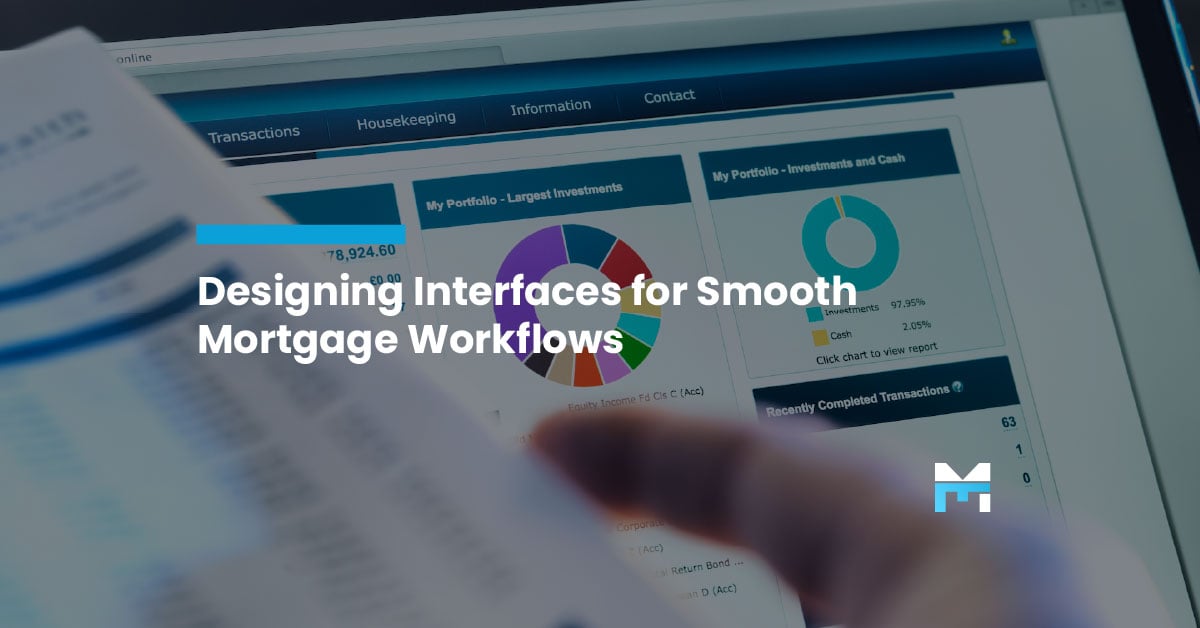1 min read
The Mortgage Tech Ecosystem Playbook: How To Build Systems That Scale, Automate, and Deliver
The mortgage industry stands at a crossroads. According to a 2023 McKinsey study, 85% of mortgage lenders have adopted some form of digital...
Information Security Compliance
Add security and compliance to Microsoft 365
BI Reporting Dashboards
Realtime pipeline insights to grow and refine your learning operation
Integrations for Banks & Credit Unions
Connect LOS, core platforms, and servicing system
Productivity Applications
Deploy customized desktop layouts for maximum efficiency
Server Hosting in Microsoft Azure
Protect your client and company data with BankGrade Security
9 min read
Justin Kirsch : Oct 23, 2025 1:00:00 PM

Modern mortgage lending demands more than just good intentions and caffeine. Your borrowers expect digital-first experiences that rival their favorite apps, while regulatory pressures continue mounting. The solution? Building mortgage workspaces with intelligent interfaces that automate the chaos and accelerate your closings.
On the surface, most mortgage teams believe their current systems are “working fine.” But the cracks show up in wasted hours, frustrated borrowers, and compliance risks hiding in plain sight.
Simple mortgage workspaces solve these challenges by eliminating silos and creating connected, automated workflows. When your loan origination system, document management platform, and CRM communicate in real time, the benefits are immediate:
And the borrower impact is even stronger. Faster approvals, transparent communication, and digital-first experiences build trust and loyalty in ways manual processes never can. Imagine compressing a timeline that traditionally stretches 30–60 days into just a few days (pending regulatory steps). That’s not just efficiency, it’s a fundamental shift in customer experience.
Pro Tip: Start small. Identify the top three bottlenecks in your current loan process (whether it’s document collection, borrower communication, or compliance checks), and focus interface improvements there first. Early wins build momentum for larger transformations.
Speed comes from a design that treats data as an asset, not something to be rekeyed.. Borrowers don’t want to wait, and neither do referral partners. Yet too often, outdated or fragmented interfaces create unnecessary delays in pre-qualification, document collection, and underwriting. Modern mortgage workspaces tackle this head-on with strategies designed to eliminate wasted time and manual effort. Below are concrete interface and integration patterns that move loans faster and reduce abandonment.
Modern integration isn’t just about “connecting systems”...it’s about creating a living data ecosystem where every platform communicates in real time. APIs (application programming interfaces) allow secure, standardized communication between servicing platforms, tax authorities, credit bureaus, payment processors, and compliance tools. Don’t bolt things together, integrate them.
Canonical data contract: Define one canonical JSON schema for borrower, asset, employment, and document metadata. Every integration (portal, LOS, CRM, third-party vendor) reads/writes against those fields. Example: borrower.contact.primaryPhone + document.bankStatement.hash + income.employmentType.
Event-driven flows: Use events for state transitions: application.submitted, document.uploaded, income.verified, clear-to-close. An event bus (Kafka, or managed pub/sub) allows parallel processing (e.g., document extraction happens without blocking UI).
Idempotent endpoints: Make APIs idempotent so retries (mobile flakiness) don’t create duplicate records. Idempotency keys on uploads and actions avoid chaos.
Backpressure & queues: Heavy jobs (OCR, validation) get queued and handled by workers so the UI remains responsive.
Example flow (intake → LOS):
Borrowers bail when the interface asks for a large, vague task. Fix that with micro-interactions.
Design for real-world issues so the borrower doesn’t experience them.
Industry research shows that 79% of mortgage professionals rate platforms that consolidate escrow-related tasks into one system as “extremely valuable” to operations. That’s the power of APIs: fewer systems to toggle between, faster processing, and a single source of truth. After implementing these interface strategies, measure your processes and see for yourself if there is improvement on speed and efficiency.
Document collection and validation have long been bottlenecks in the mortgage process. Intelligent interfaces now use AI and optical character recognition (OCR) to simplify and accelerate these tasks.
Some platforms even automatically generate Loan Estimates by combining borrower data with third-party integrations. On the back end, underwriting tools perform analyses (asset, credit, appraisal, and title) and generate conditions automatically when a borrower submits intent to proceed.
The result? Faster underwriting, fewer conditions falling through the cracks, and a smoother borrower journey from start to finish.
Borrowers live in a digital-first world where help is expected anytime, anywhere, in any language. Comprehensive interfaces can embed multilingual support features directly into borrower-facing platforms, providing personalized guidance informed by application data.
This improves borrower confidence and reduces the burden on loan officers. Instead of spending hours fielding the same questions, staff can focus on high-value conversations.
Borrower abandonment rates often spike when communication stalls. By filling that gap with 24/7 intelligent support, lenders can reduce abandonment, close more loans, and strengthen long-term loyalty.
Pro Tip: Don’t just add a chatbot…make sure it’s pulling from live borrower data in the application system. A “smart” support feature that knows the borrower’s exact stage in the process is far more effective than a generic FAQ bot.
Compliance doesn’t have to be the villain in the mortgage story. For most lenders, it’s the constant shadow…slowing processes, adding manual checks, and carrying the weight of potential penalties. Make compliance invisible by embedding it into the interface; the system should refuse invalid steps rather than flag them at the end. With intelligent interface design, compliance can become less of a hurdle and more of a built-in advantage.
This is critical when the stakes are high. Industry data shows that fee compliance errors can cost lenders over $1 million per 1,000 loans, with nearly 40% of loans impacted by tolerance cures. Manual checks simply can’t keep up with this level of scrutiny. Automated validation can.
Design your interfaces to emit these artifacts automatically; auditors love tidy packages:
Smart systems don’t just process loans; they document every action. From borrower disclosures to internal hand-offs, integrated systems create traceable, time-stamped records. This makes audits less of a fire drill and more of a quick review. Every data point and decision is visible, reducing risk and protecting lender credibility.
When information moves manually (via uploads, emails, or spreadsheets), errors are almost inevitable. Interfaces that allow real-time data transfer eliminate those weak points. Loan data flows consistently from one system to another without human touchpoints, reducing discrepancies and building a foundation of accuracy.
Overall Point: Compliance doesn’t have to be a burden. When designed into the interface from the start, it becomes invisible, automatically protecting lenders while allowing teams to focus on serving borrowers.
Numbers tell the story more clearly than any sales pitch. Lenders who adopt intelligent interfaces and seamless mortgage workspaces consistently see measurable gains across speed, cost, and borrower satisfaction.
Institutions embracing interface-driven automation report:
Assumptions (example conservative):
Per-loan labor savings: (10 − 4) × $60 = $360
Annual labor savings: 2,000 × $360 = $720,000
Processing speed impact (conservative): 20% faster cycle → increases pull-through by 3% (more funded loans).
Revenue upside: 2,000 × 3% × $3,000 = $180,000
Total first-year value (labor + incremental funded revenue): $900,000
This conservative example assumes modest automation gains. If you scale extraction coverage and e-sign adoption further, numbers rise quickly.
With built-in compliance checks and automated data validation, tolerance cures and disclosure timing errors are dramatically reduced. Instead of catching problems post-close (when fixes are expensive), lenders prevent errors before they leave the system. The result is lower regulatory risk, fewer costly reworks, and smoother audits.
The borrower side of the story is just as powerful. With automated underwriting, faster document verification, and clear communication tools, borrowers enjoy a digital-first experience that matches the convenience they expect in every other part of their financial lives.
Key benefits include:
Borrowers notice the difference. In fact, industry surveys show that lenders offering modern, digital-first processes report significantly higher borrower satisfaction and repeat business rates.
Big Picture: Integrated interfaces don’t just make life easier for lenders; they build lasting trust with borrowers. In a relationship-driven industry, that trust becomes a growth engine.
The mortgage industry is evolving faster than ever. Borrowers expect digital-first experiences, regulators demand tighter compliance, and lenders face increasing pressure to do more with fewer resources. The reality is simple: fragmented systems can’t keep up.
Simple mortgage workspaces provide a clear path forward. By integrating platforms, automating manual processes, and embedding compliance into every step, lenders can accelerate closings, reduce costs, and deliver the transparent experience borrowers expect.
Mortgage Workspace specializes in building these intelligent ecosystems. Our solutions are designed for mortgage professionals who want more than “good enough”...they want efficiency, compliance, and scalability built into their operations from day one.
Final Thought: Technology should remove friction, not create it. With the right interface strategies, your team can spend less time fixing errors and more time closing loans, serving borrowers, and growing your business.
Schedule your consultation today and discover how the right interface strategies can transform your closings, compliance, and bottom line.

1 min read
The mortgage industry stands at a crossroads. According to a 2023 McKinsey study, 85% of mortgage lenders have adopted some form of digital...

.jpg)
Picture this: You're cruising through your loan disclosure statements, feeling confident about your work, when suddenly you spot it—a typo that could...